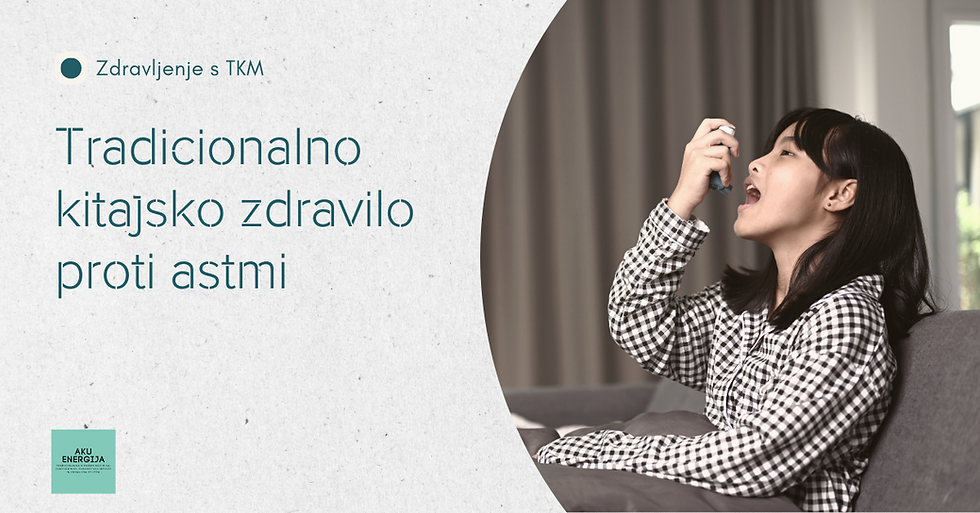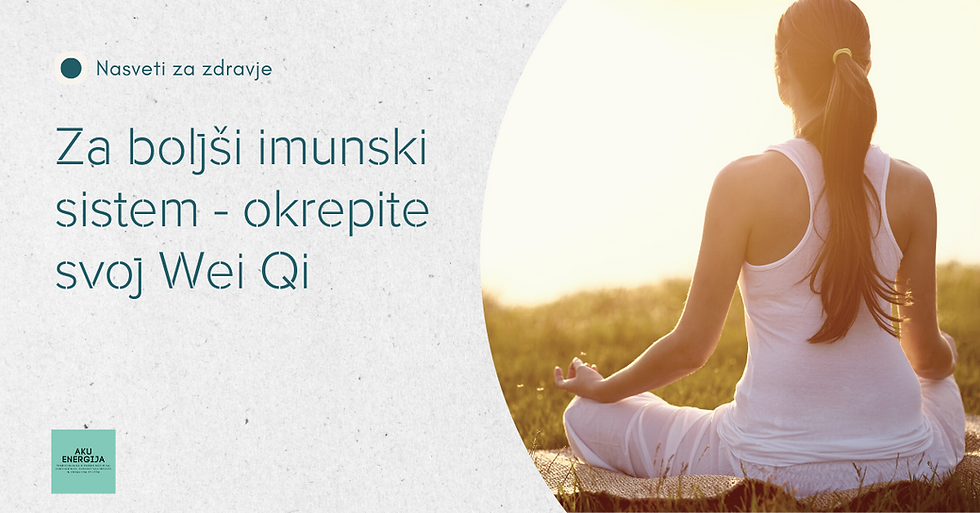Tradicionalno kitajsko zdravilo proti astmi
- Aku Energija
- Apr 1, 2018
- Branje traja 6 min
Updated: Apr 11, 2023
Astma je zelo pogosta bolezen. Svetovna zdravstvena organizacija (SZO) je ocenila, da zanjo trpi približno 300 milijonov ljudi po vsem svetu. Tipični simptomi astme so sopenje (žvižgajoč zvok v prsih), primanjkovanje diha, kašljanje in tesen občutek v prsih, ki ga povzroča zapora v dihalnih poteh, ki nastane kot posledica vnetja ali mišičnih krčev. Astma se lahko pojavi v vseh starostih, če jo zanemarimo, pa se lahko ponavlja in postane kronična.

Kitajska zdravilna zelišča se za zdravljenje astme uporabljajo že več kot tisoč let. Zhang Zhongjing je bil eden najbolj znanih kitajskih zdravnikov. Vzpostavil je posebno teorijo zdravljenja in povzel izkušnje z zdravljenjem, vključno z astmo, ki so še vedno učinkovite in jih kitajski zdravniki še uporabljajo. Na splošno je potrebno kitajska zdravilna zelišča dobro organizirati v kompleksno formulo, s katero se bolezni zdravijo na podlagi edinstvene teorije in diagnoze.
Je simptome astme res mogoče odpraviti?
V praksi pri zdravljenju s TKM na klinikah ne želimo le nadzirati simptomov astme, temveč se trudimo, da bi jih dolgoročno odpravili. Ta cilj je popolnoma dosegljiv z dvodelnim pristopom:
Simptome spravimo pod nadzor z zatiranjem zunanjih patogenov (navadno prehlad, gripa ali druga okužba zgornjih dihalnih poti).
S toniki ter protialergijskimi zelišči za uravnavanje imunosti utrdimo pljuča ter umirimo imunski odziv.
Zdravljenje TKM je neprecenljivo prav zaradi druge faze, saj konvencionalna medicina še ni razvila zdravil, ki bi lahko to dosegla, pacienti pa so zato za vedno odvisni od inhalacijskih naprav. [Preberi več: TKM vs zahodna medicina]
Kaj povzroča astmo?
Orientalska medicina navaja, da obstaja veliko dejavnikov, ki lahko sprožijo napad astme. Med drugim so to napad zunanjih patogenov, prehrana, čustvene motnje, prirojene šibkosti in kronične bolezni.
Zunanji patogeni, kot sta mraz in toplota, pogosto povzročajo napade astme. V skladu s teorijo TKM pljučni sistem koži zagotavlja energijo za obrambo proti zunanjim patogenom. Ker okolje vpliva na kožo, se spremembe odražajo v pljučih. Ko so pljuča napadena, je njihova funkcija uravnavanja vodnih kanalov poškodovana, zato začne voda stagnirati, pacientu pa začne teči iz nosa in njegovi izmečki postanejo beli. Ko se izmečki še naprej nabirajo in je energija telesa, s katero bi jih odstranilo, šibka, so dihalne poti ovirane, kar povzroči težave z dihanjem.
Astmo lahko sproži tudi prehrana. Surova in hladna hrana lahko poškoduje vranico in navadno pripomore k stagnaciji tekočin ter povečanem proizvajanju sluzi. Težka, sladka in mastna hrana ponavadi v telesu ustvari sluz in vročino. Tudi za ribe, rake, lupinarje in drugo morsko hrano je bilo opaženo, da poveča možnost napadov astme. [Preberi več: Lastnosti hrane] [Preberi več: Hrano je potrebno skuhati – tradicionalna kitajska medicina pojasni prebavni sistem]
Prav tako so pogosti vzroki za astmo prirojene šibkosti ter kronične bolezni. Otroci z astmo imajo v splošnem prirojeno pomanjkanje energije Qi v ledvicah. Po drugi strani je zelo verjetno, da bodo pacienti s kroničnimi boleznimi, kot sta kronični kašelj in prehlad/gripa, ki se ponavlja, trpeli za pomanjkanjem pljučne energije.
Kako kitajska medicina ponavadi zdravi astmo?
Zdravljenje z akupunkturo proti astmi
Akupunktura lahko pomaga sprostiti napete mišice in blokade brez stranskih učinkov, ki so zelo pogosti pri konvencionalnih metodah zdravljenja kot npr. z inhalacijskimi napravami. Akupunktura telo umiri in lajša simptome astmatičnega napada. Prav tako sprosti blokade v meridianih, zaradi česar se lahko obrambni Qi nemoteno pretaka po telesu. Akupunktura lahko pomaga sprostiti parasimpatično živčevje ter povečati sproščanje nevrotransmiterjev v možgane. Nekateri pacienti lahko izboljšanje stanja vidijo že po prvem zdravljenju z akupunkturo.
Pogost pristop je akupunktura telesa, ki utrdi ledvice in pljuča. Uporabijo se različne akupunkturne točke, ki so odvisne od pacientove konstitucije ter razlogov za astmo.
Kitajska zdravilna zelišča proti astmi
Mešanica kitajskih zelišč pomaga utrditi pljučni in imunski sistem. Zdravljenje z zelišči učinkovito zmanjšuje možnost ponovitve astmatičnega napada. Izvajalec predpiše zeliščno formulo, ki temelji na telesni konstituciji, stanju astme, njenem izvoru ter posebnih potrebah pacienta.
Zelišča, ki se pogosto uporabljajo pri zdravljenju astme in bronhitisa, so:
Marelično seme (Xing Ren), korenina zvončice (Jie Geng) za odstranjevanje sluzi ter zmanjševanje sopenja
Sladki koren (Gan Cao) in atractylodes macrocephala (Bai Zhu) za izboljšanje zaloge Qija in blaženje kašlja s spodbujanjem nemotene cirkulacije Qija
Angelika (Dang Gui) za izboljšanje cirkulacije krvi v pljučnem sistemu
Rdeči deževnik (Di Long) za razširitev bronhiolov ter lajšanje sopenja
Lilija (Bai He) in korenina glehnia (Bei Sha Shen) za izboljšanje delovanja pljuč
Kombinacija zdravljenj
Kombinacija akupunkture z zdravilnimi zelišči in tretmaji, kot so ventuze, tretma z zeliščno paro ter moksibustija, katerih cilj je zmanjšati pomanjkanje obrambnega Qija, je učinkovitejša in jo tudi priporočamo.
Traditional Chinese Medicine for Asthma
Asthma is a very common condition. It is affecting approximately 300 million people worldwide estimated by WHO. Its typical symptoms are wheezing (a whistling noise in the chest), shortness of breath, coughing and a tight feeling in the chest caused by obstruction of the airways as a result of inflammation or muscle spasm. Asthma may begin at any age and, if neglected, tends to recur and become chronic.
Chinese herbal medicine has been used for asthma treatment for over thousand years. Zhang Zhongjing, was one of the most famous Chinese physicians in history. He established special medication theory and summed up the medical experience including asthma which is still effective and widely used by Chinese physicians. In general, Chinese herb medicine needs to be organised well in a complex formula to treat disease based on unique theory and diagnosis.
Is it really possible to eliminate asthma symptoms?
In actual TCM clinical practice, we do not aim only for symptom control of the asthma, but rather for its long term elimination. This is very achievable with a two pronged approach:
Control symptoms by eradicating external pathogenic (usually a cold, a flu or other upper respiratory tract infection)
Strengthen the lung and calm the immune response with tonics and anti-allergic, immune modulating herbs.
It is this second phase of treatment that makes TCM treatment priceless, because conventional medicine simply has not developed drugs that are able to accomplish this, leaving patients forever dependent on inhalers. [Read more: TCM vs Western Medicine]
What causes asthma?
In Oriental Medicine, there are many factors that may trigger an asthma attack. Examples include the invasion of the external pathogenic factors, diet, emotional disturbances, congenital weakness and chronic illnesses.
External pathogenic factors, such as cold or heat, commonly induce asthma attacks. In the TCM theory, the Lung system provide energy to the skin for defense against external pathogens. As the environment affects the skin, the change is reflected in the Lung. When the Lung is under attack, its function to regulate water passage becomes impaired, water begins to stagnate so patient start to have runny nose and white sputum. When the sputum further builds up and the body is weak in energy to remove them, therefore airway is obstructed causing difficulty in breathing.
Diet can also trigger asthma. Raw and cold food may injure the Spleen and tend to contribute to the stagnation of fluid circulation and the increase in the production of phlegm. Heavy, sweet, and greasy food tend to create phlegm and heat in the body. Fish, crabs, shellfish and other seafood have also been noted to increase the likelihood of asthma attacks as well. [Read more: Properties of food] [Read more: Cook your food - digestive system explained in Traditional Chinese medicine]
Congenital weakness and chronic illness are also common causes of asthma. Children with asthma generally have congenital Kidney Qi deficiency. On the other hand, chronic illness, such as patients with chronic cough and recurrent cold/flu, are likely to have Lung deficiency.
How Is Chinese Medicine Used to Treat Asthma?
Acupuncture Treatment for Asthma
Acupuncture can help to release naturally tensioned muscles and blockades without side-effects that are very common with conventional treatment methods such as inhalers. Acupuncture calms the body and relieves symptoms of an asthmatic attack. It also releases blockages in the meridian channels helping the defensive Qi to flow smoothly through the body. Scientifically Acupuncture can help to relax the parasympathetic nervous system and increase the release of neurotransmitters to the brain. Some patients already see improvements of their condition after their first acupuncture treatment.
A common approach is using body acupuncture that strengthens kidneys and lungs. Depending on the constitution of the patient and reason for the asthma condition a variety of different points are used.
Chinese Herbal Medicine for Asthma
Mixture of Chinese herbs helps to strengthen the lungs and immune system. Herbal treatment is efficient in reducing the likelihood of a return of an asthma attack. Based on the body constitution, asthma condition and origin and specific needs of the patient the practitioner will prescribe an herbal formula.
Common herbs used in the treatment of asthma and bronchitis are:
Apricot seed (Xing Ren), Bellflower root (Jie Geng), to eliminate phlegm and reduce wheezing
Licorice (Gan Cao) and Atractylodes macrocephala (Bai Zhu) to improve the supply of Qi and reduce coughing by promoting smooth circulation of Qi
Angelica (Dang Gui) to improve the blood circulation of the Lung system
Lumbricus (Di Long) to dilate the bronchioles and relieve wheezing
Lili (Bai He) and Glehniae Radix (Bei Sha Shen) for improving lung function
A Combination of Treatments
A combination of acupuncture with herbal medicine and treatments aiming to improve the deficiency of defensive Qi such as cupping, herbal steaming or moxibustion tends to be more effective and is advisable.







Komentarji